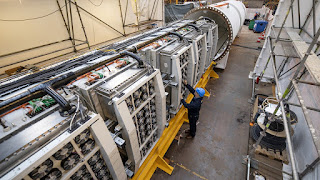Does the future of the datacenter lie under the sea?
Is it possible to exploit submarine technology to run underwater autonomous datacenters capable of delivering cloud services at lightning speed to coastal cities? This is the bet that Microsoft has with its Project Natick. The first phase of the project has shown that the concept of submarine data centers is feasible, now the research team wants to determine if the same concept is feasible from a logistic, environmental and economic point of view.
More than half of the world's population lives near the coast, installing data centers in containers near coastal cities, the data will have a limited distance to reach communities. The goal is to improve the web browsing experience, video streaming, online gaming and offer authentic experiences for AI technologies.
The 12-meter datacenter used by the Natick Project is a white cylinder, consisting of 12 bays with a total of 864 servers and an infrastructure cooling system. The datacenter was assembled and tested in France before it was shipped to Scotland. A triangular base makes it possible to position the datacenter at the bottom of the sea. And an underwater cable feeds the data center and allows it to communicate with the shore and the Internet.
Through this second phase of the project, Microsoft is looking to reduce the energy bill by placing servers under water. In this way, the researchers hope that the temperature of the underwater environment will cool the data center.
"We think that we are actually getting much better underwater cooling than on the surface," says project manager Ben Cutler. "Moreover, because there is no personnel on the site, we can remove all the oxygen and most of the water vapor, which reduces corrosion, which is a major problem in data centers. "
It will not be possible to repair the computers if they fail, but researchers hope that the default rate of machines will be lower than in conventional data centers.
The size of this datacenter is quite small compared to the giant datacenters that currently store our data. With only 12 server bays, there will be just enough room to store 27.6 petabytes of data, equivalent to 5 million movies.
Datacenters: the backbone of the Internet
It's hard to imagine today's Internet without datacenters, the huge farms where physical clouds of cloud services take advantage of economies of scale to store and process data, drive machine learning models, and run AI algorithms.
The demand for datacenter resources is growing exponentially as companies increasingly take their networks and IT needs to the cloud. Then there is the proliferation of smart connected objects that range from smartphones to robots. This reality underscores the need to innovate in the drive to deploy datacenters that are becoming a critical piece of 21st century infrastructure, says Cutler.
The underwater datacenter concept was first introduced in a white paper prepared for a Microsoft event called ThinkWeek. This event encourages the firm's employees to share their original ideas. The group of Peter Lee, vice president of AI and research at Microsoft was quickly captivated. In just 12 months after the launch of the Natick Project in July 2014, the team deployed a prototype in calm, shallow waters in California.
Encouraged by the results of this demonstration, the Natick Project undertook to design and test the current module deployed in Scotland. Cutler has informed that the new version is designed to remain in maintenance-free operation for five years.
Engineers are installing the servers and associated cooling system for the undersea data center infrastructure at Naval Group's Brest, France facility.
In phase 2 of the project, the Microsoft team recognized that designing underwater data centers requires outside expertise. That's why the firm chose to work with Naval Group, a 400-year-old French company with global expertise in engineering, manufacturing and maintenance of military-style vessels and submarines, as well as marine energy technologies. .
The Microsoft team presented Naval Group with the specifications of its underwater datacenter and let the company design and build the deployed cylinder.
